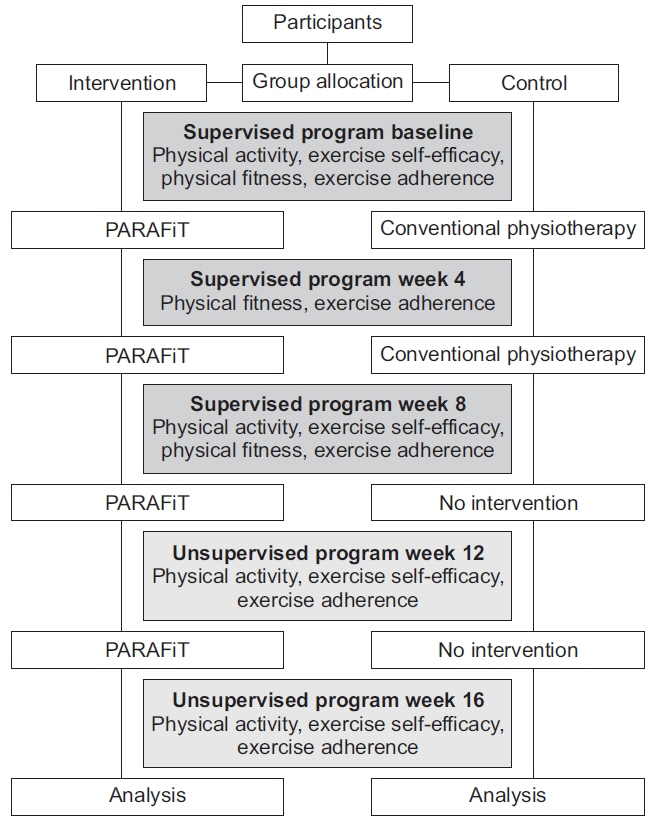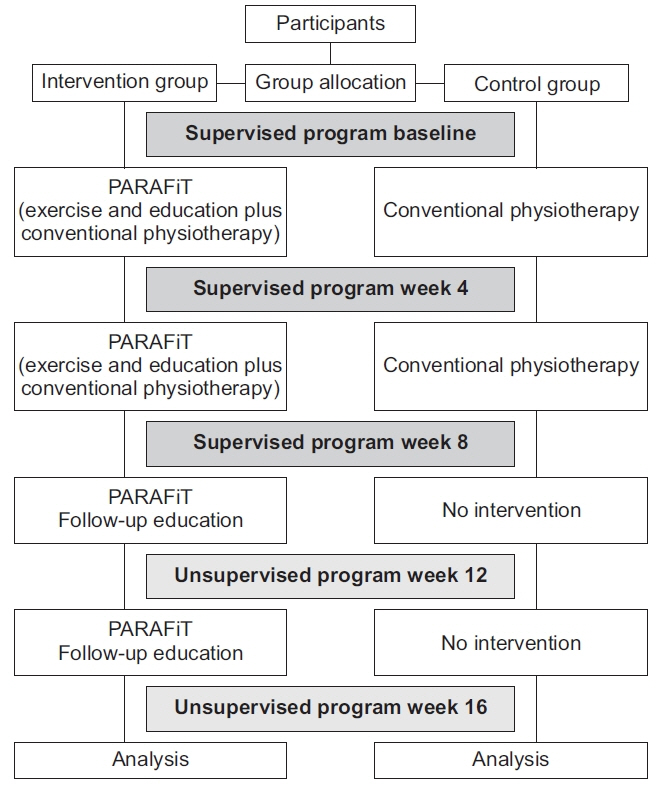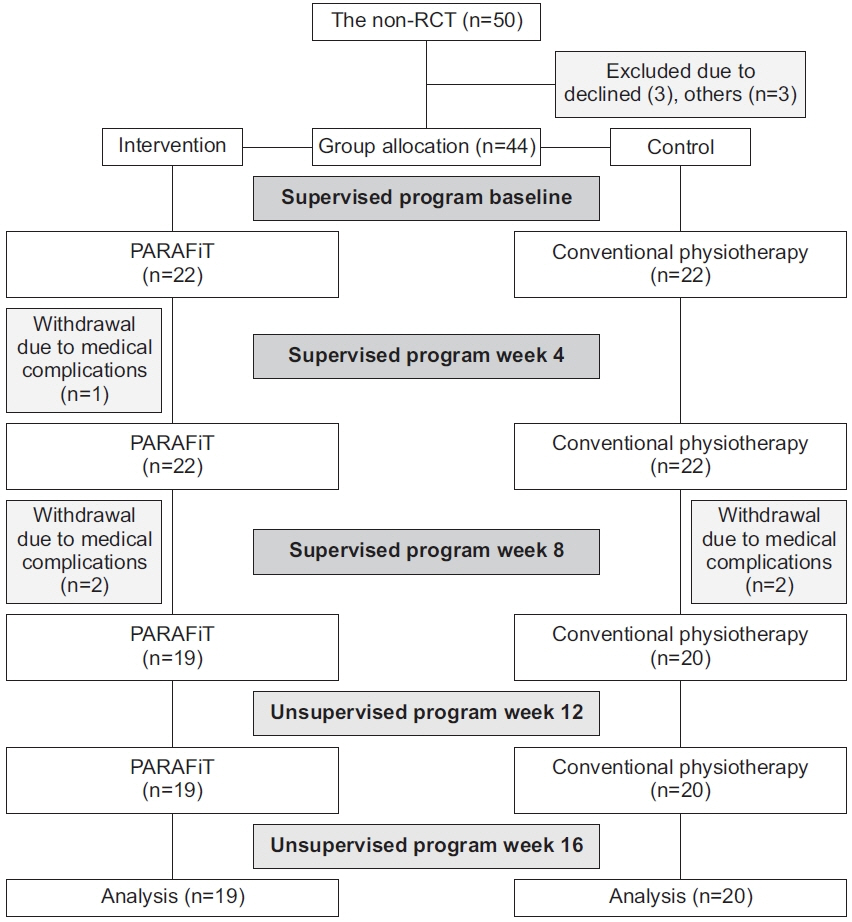Ann Rehabil Med.
2022 Feb;46(1):33-44. 10.5535/arm.21127.
Effects of Paraplegia Fitness Integrated Training on Physical Function and Exercise Self-Efficacy and Adherence Among Individuals With Spinal Cord Injury
- Affiliations
-
- 1Centre for Physiotherapy, Faculty of Health Sciences, Universiti Teknologi MARA, Puncak Alam Campus, Puncak Alam, Malaysia
- 2Pusat Rehabilitasi PERKESO, Melaka, Malaysia
- 3Department of Rehabilitation Medicine, Faculty of Medicine, Universitiy of Malaya, Kuala Lumpur, Malaysia
- 4Clinical and Rehabilitation Exercise Research Group, Faculty of Health Sciences, Universiti Teknologi MARA, Puncak Alam Campus, Puncak Alam, Malaysia
- KMID: 2527097
- DOI: http://doi.org/10.5535/arm.21127
Abstract
Objective
To determine the effects of the Paraplegia Fitness Integrated Training (PARAFiT) program, which is an integrated graded physical exercise and health education program for individuals with spinal cord injury (SCI).
Methods
This nonrandomized single-blind study included 44 participants, who were assigned to either an intervention (PARAFiT) group or an active control (conventional physiotherapy) group. The intervention group underwent the PARAFiT program (8 weeks), which consisted of circuit-based interval training, progressive upper limb resistance training, and health education sessions. During the unsupervised period, the intervention group continuously underwent health education program once a month for 2 months (8 weeks). Repeated-measures analysis of variance was used for the analysis.
Results
The intervention group presented with a higher level of physical activity than did the control group; however, the difference was not significant (p=0.36). Additionally, the intervention group presented with better exercise self-efficacy and cardiorespiratory fitness and stronger bilateral shoulder muscle and handgrip than did the control group (all p<0.05). Exercise adherence was higher in the intervention group than in the control group during both the supervised (80% vs. 75%) and unsupervised (40% vs. 20%) periods.
Conclusion
The PARAFiT program enhanced the level of physical activity, exercise self-efficacy, physical fitness, and exercise adherence among the patients with SCI. Future studies should incorporate guidelines for home-based exercises and regular monitoring to promote long-term adherence to exercise and physical activity among individuals with SCI.
Figure
Cited by 1 articles
-
Risk Factors for Suicidality in Individuals With Spinal Cord Injury: A Focus on Physical and Functional Characteristics
Sora Han, Wooyeung Kim, Onyoo Kim
Ann Rehabil Med. 2023;47(5):377-384. doi: 10.5535/arm.23110.
Reference
-
1. Nooijen CF, de Groot S, Postma K, Bergen MP, Stam HJ, Bussmann JB, et al. A more active lifestyle in persons with a recent spinal cord injury benefits physical fitness and health. Spinal Cord. 2012; 50:320–3.
Article2. Ysasi NA, Kerwin S, Marini I, McDaniels B, Antol DL. A comprehensive literature review of secondary complications of spinal cord injury. J Life Care Plan. 2016; 14:25–58.3. Shojaei MH, Alavinia SM, Craven BC. Management of obesity after spinal cord injury: a systematic review. J Spinal Cord Med. 2017; 40:783–94.
Article4. Stevens SL, Caputo JL, Fuller DK, Morgan DW. Physical activity and quality of life in adults with spinal cord injury. J Spinal Cord Med. 2008; 31:373–8.
Article5. Hetz SP, Latimer AE, Ginis KA. Activities of daily living performed by individuals with SCI: relationships with physical fitness and leisure time physical activity. Spinal Cord. 2009; 47:550–4.
Article6. Maher JL, McMillan DW, Nash MS. Exercise and health-related risks of physical deconditioning after spinal cord injury. Top Spinal Cord Inj Rehabil. 2017; 23:175–87.
Article7. Nooijen CF, Post MW, Spooren AL, Valent LJ, Broek-steeg R, Sluis TA, et al. Exercise self-efficacy and the relation with physical behavior and physical capacity in wheelchair-dependent persons with subacute spinal cord injury. J Neuroeng Rehabil. 2015; 12:103.
Article8. Vissers M, van den Berg-Emons R, Sluis T, Bergen M, Stam H, Bussmann H. Barriers to and facilitators of everyday physical activity in persons with a spinal cord injury after discharge from the rehabilitation centre. J Rehabil Med. 2008; 40:461–7.
Article9. Scelza WM, Kalpakjian CZ, Zemper ED, Tate DG. Perceived barriers to exercise in people with spinal cord injury. Am J Phys Med Rehabil. 2005; 84:576–83.
Article10. Mat Rosly M, Halaki M, Hasnan N, Mat Rosly H, Davis GM, Husain R. Leisure time physical activity participation in individuals with spinal cord injury in Malaysia: barriers to exercise. Spinal Cord. 2018; 56:806–18.
Article11. Nooijen CF, Stam HJ, Bergen MP, Bongers-Janssen HM, Valent L, van Langeveld S, et al. A behavioural intervention increases physical activity in people with subacute spinal cord injury: a randomised trial. J Physiother. 2016; 62:35–41.
Article12. Hicks AL, Martin Ginis KA, Pelletier CA, Ditor DS, Foulon B, Wolfe DL. The effects of exercise training on physical capacity, strength, body composition and functional performance among adults with spinal cord injury: a systematic review. Spinal Cord. 2011; 49:1103–27.
Article13. van der Scheer JW, Martin Ginis KA, Ditor DS, GooseyTolfrey VL, Hicks AL, West CR, et al. Effects of exercise on fitness and health of adults with spinal cord injury: a systematic review. Neurology. 2017; 89:736–45.
Article14. Tweedy SM, Beckman EM, Geraghty TJ, Theisen D, Perret C, Harvey LA, et al. Exercise and sports science Australia (ESSA) position statement on exercise and spinal cord injury. J Sci Med Sport. 2017; 20:108–15.
Article15. Tawashy AE, Eng JJ, Krassioukov AV, Miller WC, Sproule S. Aerobic exercise during early rehabilitation for cervical spinal cord injury. Phys Ther. 2010; 90:427–37.
Article16. McMillan DW, Maher JL, Jacobs KA, Nash MS, Bilzon JL. Physiological responses to moderate intensity continuous and high-intensity interval exercise in persons with paraplegia. Spinal Cord. 2021; 59:26–33.
Article17. Martin Ginis KA, van der Scheer JW, Latimer-Cheung AE, Barrow A, Bourne C, Carruthers P, et al. Evidence-based scientific exercise guidelines for adults with spinal cord injury: an update and a new guideline. Spinal Cord. 2018; 56:308–21.
Article18. Washburn RA, Zhu W, McAuley E, Frogley M, Figoni SF. The physical activity scale for individuals with physical disabilities: development and evaluation. Arch Phys Med Rehabil. 2002; 83:193–200.
Article19. van der Ploeg HP, Streppel KR, van der Beek AJ, van der Woude LH, Vollenbroek-Hutten M, van Mechelen W. The Physical Activity Scale for Individuals with Physical Disabilities: test-retest reliability and comparison with an accelerometer. J Phys Act Health. 2007; 4:96–100.
Article20. Kroll T, Kehn M, Ho PS, Groah S. The SCI Exercise Self-Efficacy Scale (ESES): development and psychometric properties. Int J Behav Nutr Phys Act. 2007; 4:34.
Article21. Cowan RE, Callahan MK, Nash MS. The 6-min push test is reliable and predicts low fitness in spinal cord injury. Med Sci Sports Exerc. 2012; 44:1993–2000.
Article22. Collado-Mateo D, Dominguez-Munoz FJ, Batalha N, Parraca J, Tomas-Carus P, Adsuar JC. Test-retest reliability of isokinetic arm strength measurements in competitive swimmers. J Hum Kinet. 2018; 65:5–11.
Article23. Drouin JM, Valovich-mcLeod TC, Shultz SJ, Gansneder BM, Perrin DH. Reliability and validity of the Biodex system 3 pro isokinetic dynamometer velocity, torque and position measurements. Eur J Appl Physiol. 2004; 91:22–9.
Article24. Sisto SA, Dyson-Hudson T. Dynamometry testing in spinal cord injury. J Rehabil Res Dev. 2007; 44:123–36.
Article25. Mathiowetz V. Comparison of Rolyan and Jamar dynamometers for measuring grip strength. Occup Ther Int. 2002; 9:201–9.
Article26. Pelletier CA, Totosy de Zepetnek JO, MacDonald MJ, Hicks AL. A 16-week randomized controlled trial evaluating the physical activity guidelines for adults with spinal cord injury. Spinal Cord. 2015; 53:363–7.
Article27. Totosy de Zepetnek JO, Pelletier CA, Hicks AL, Mac Donald MJ. Following the physical activity guidelines for adults with spinal cord injury for 16 weeks does not improve vascular health: a randomized controlled trial. Arch Phys Med Rehabil. 2015; 96:1566–75.28. Nash MS, van de Ven I, van Elk N, Johnson BM. Effects of circuit resistance training on fitness attributes and upper-extremity pain in middle-aged men with paraplegia. Arch Phys Med Rehabil. 2007; 88:70–5.
Article29. Brouwers MC, Kho ME, Browman GP, Burgers JS, Cluzeau F, Feder G, et al. AGREE II: advancing guideline development, reporting and evaluation in health care. CMAJ. 2010; 182:E839–42.
Article30. Bakkum AJ, de Groot S, Stolwijk-Swuste JM, van Kuppevelt DJ; ALLRISC, van der Woude LH, et al. Effects of hybrid cycling versus handcycling on wheelchair-specific fitness and physical activity in people with long-term spinal cord injury: a 16-week randomized controlled trial. Spinal Cord. 2015; 53:395–401.
Article31. Ashford S, Edmunds J, French DP. What is the best way to change self-efficacy to promote lifestyle and recreational physical activity? A systematic review with meta-analysis. Br J Health Psychol. 2010; 15(Pt 2):265–88.
Article32. Mat Rosly M, Halaki M, Mat Rosly H, Davis GM, Hasnan N, Husain R. Malaysian adaptation of the physical activity scale for individuals with physical disabilities in individuals with spinal cord injury. Disabil Rehabil. 2020; 42:2067–75.
Article33. de Groot S, van der Woude LH, Niezen A, Smit CA, Post MW. Evaluation of the physical activity scale for individuals with physical disabilities in people with spinal cord injury. Spinal Cord. 2010; 48:542–7.
Article34. Baattaiah BA, Murray D, Cowan R, Groah SL, Liungberg IH, Rounds AK, et al. Association of six minute push test distance and measures of cardiorespiratory fitness in spinal cord injury. Med Sci Sport Exerc. 2017; 49(5S):409.
Article35. Solanki R, Chaudhari P, Bhise A. Cardio respiratory fitness testing in spinal cord injury patients using 6 minute push test. Healthline J. 2016; 7:60–3.36. Qi L, Ferguson-Pell M, Salimi Z, Haennel R, Ramadi A. Wheelchair users’ perceived exertion during typical mobility activities. Spinal Cord. 2015; 53:687–91.
Article37. Ambrosio F, Boninger ML, Souza AL, Fitzgerald SG, Koontz AM, Cooper RA. Biomechanics and strength of manual wheelchair users. J Spinal Cord Med. 2005; 28:407–14.
Article
- Full Text Links
- Actions
-
Cited
- CITED
-
- Close
- Share
- Similar articles
-
- Effects of Graded Exercises Integrated with Education on Physical Fitness, Exercise Self-Efficacy, and Activity Levels in People with Spinal Cord Injury: A Quasi-Experimental Study Protocol
- Effects of Resistance Circuit Training on Health-Related Physical Fitness in People With Paraplegia: A Pilot Randomized Controlled Trial
- Paraplegia Following Spinal Cord Contusion from an Indirect Gunshot Injury
- An Explanatory Model for Patient Adherence of Rehabilitation in patients with Spinal Cord Injury
- Paraplegia due to Spinal Cord Infarction After Lifting Heavy Objects




